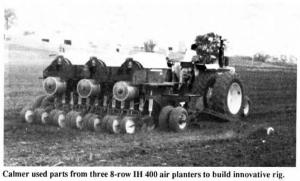1991 - Volume #15, Issue #5, Page #15
[ Sample Stories From This Issue | List of All Stories In This Issue | Print this story
| Read this issue]
24 Row Equidistant Soybean Air Planter
 |
The 24-row "equidistant" air planter, built by Marion Calmer, Alpha, Ill., uses parts from three 8-row, 30-in. International 400 air planters.
"As far as I know it's the only planter that can plant in 6-in. wide rows and also space seeds 6 in. apart inside the row," says Calmer, who built his planter 1 1/2 years ago. "If I wanted to plant soybeans more accurately, I'd have to plant them by hand. Equidistant seed spacing gives each plant more growing area. I'm still testing to see if near-perfect seed spacing results in significantly higher soybean yields. Even if equidistant seed spacing doesn't prove out yield-wise, I know that my planter's seed metering system is more accurate and easier to calibrate than the metering system on any drill, and depth control is just as good."
Calmer welded two planter frames together - one ahead of the other - with a 5 by 7-in. toolbar (salvaged from an old IH 500 planter) in between for extra strength. A drop axle, equipped with dual wheels on each end and mounted under the two frames, hydraulically raises and lowers the planter. Each planter frame carries 12 row units salvaged from the IH 400 planters. The row units are spaced 12 in. apart and staggered to create 6-in. rows. Calmer narrowed the stabilizing arches at the rear of the row units from 30 to 12 in. and welded them back together. The three seed hoppers and blowers are bolted to the three IH 400 transmissions which Calmer welded on top of the planter frame.
According to Calmer, the key to equidistant spacing on his planter is that each blower has to service only 4 ft. of planter width (8 row units). As a result, seed drops almost straight down through the seed tubes and can be blown with about half as much air pressure. "On a conventional 8-row 30-in. planter the blower is 10 ft. from the outside row units and the seed tubes run in a more diagonal fashion," says Calmer. "The higher air speed that's required causes seed to bounce off the sides of the seed tube which results in uneven spacing.
"One drawback to my system is that I can only get near-perfect equidistant spacing when I travel at about 1 3/4 mph. Part of the reason is that seed drum rotation isn't very smooth on old IH planters. However, even when I plant at 6 mph I can place seed much more accurately than I could with a conventional drill. I hope to improve seed spacing precision at higher travel speeds by replacing the round seed tube manifolds with square ones and smoothing the rotation of the drum. The three hoppers hold a total of 40 bu. of seed and let me plant 35 acres per fill. It takes about six hours to empty the planter once I load up."
The planter weighs 10,060 lbs. when filled with seed. Calmer mounted a length of 1/2-in. thick flat steel under the tongue (removed from one of the IH 400 planters) to absorb some of the weight and also beefed up the hitch. A support chain leading from the hitch to the tractor 3-pt. also helps absorb the weight.
The three blowers are pto-driven. An 8-ft. long pto shaft direct-drives the center blower and belt-drives the other two blowers. "A single hydraulic pump wouldn't have enough capacity to operate all three blowers," says Calmer. "We decided not to use hyraulic drive because we would have needed two pumps and also it would have been more difficult to slow down the air speed."
Contact: FARM SHOW Followup, Marion Calmer, Calmer Farms, Alpha, Ill. 61413 (ph 309 334-2609).

Click here to download page story appeared in.

Click here to read entire issue
To read the rest of this story, download this issue below or click here to register with your account number.




